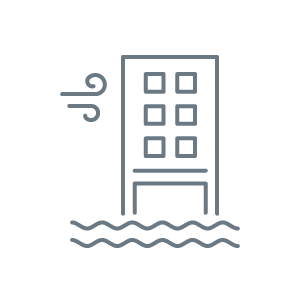 On March 1st, GRESB released the Reference Guide for a new Resilience Module, an optional supplement for the GRESB Real Estate and Infrastructure Assessments.
On March 1st, GRESB released the Reference Guide for a new Resilience Module, an optional supplement for the GRESB Real Estate and Infrastructure Assessments.
This article offers a quick overview of our motivations, goals, key definitions, module structure, and next steps for investors and participants. The Resilience Module will be available for use with the GRESB Real Estate and Infrastructure Assessments on April 1st.
Motivation
Real asset investors increasingly recognize that investment returns may be at risk from social and environmental shocks and stressors. This reflects growing awareness about the implications of long-term trends in climate, urbanization, population, and related factors. Individually and collectively these issues suggest that historic assumptions are unlikely to be reliable guides to future conditions. Consequently, investors are asking new questions about how companies are assessing social and environmental risks and, in turn, how they are acting on the results of these assessments to protect business value, maintain continuity of operations, and safeguard human health and the environment.
At the same time, property and infrastructure companies have also identified the same trends, and they have begun to take action, often far in advance of questions from investors. Property and infrastructure companies are developing new risk assessment approaches and acting to prepare for changing conditions. Recent examples of industry leadership include:
- Stockland’s development of a climate resilience assessment methodology, an innovative approach combining the analysis of climate effects, property elements, and climate risks to produce an asset-level climate-resilience score.
- Lend Lease’s efforts to enhance resilience in the state-of-the-art Barangaroo project, including its Climate Change Adaptation & Community Resilience plan for Barangaroo South.
- Forest City’s work to accommodate future sea level rise through the design of the Pier 70 project in San Francisco.
Goal
The Resilience Module has two primary goals:
- Meet investor demand for information about the resilience of property and infrastructure companies and funds; and
- Provide more information about strategies used by property and infrastructure companies to assess and manage risks from social and environmental shocks and stressors, including the impact of climate change.
Definition
The development of the Resilience Module was predicated on recognition that resilience is a broad concept, which is used in many different ways. Consequently, there is no single, authoritative definition of resilience. The Resilience Module operationally defines resilience as the capacity of companies and funds to survive and thrive in the face of social and environmental shocks and stressors.
This definition encompasses physical, economic, and social dimensions of resilience, including, but not limited to, climate change. This definition includes consideration for both short-term shocks and long-term stressors. Shocks are big, acute events that disrupt a system, such as floods, fires, earthquakes, terrorist attacks. Stressors are the underlying vulnerabilities that leave companies and communities susceptible when shocks occur, such as poverty, income inequality, environmental degradation, aging infrastructure. Managing for resilience includes both preparing and responding to shocks, as well as addressing underlying stressors. Organizations that take a systemic and integrated approach to understanding the shocks they face and the stressors they experience generally find improved performance and ability to recognize and respond to opportunity, sometimes referred to as a “resilience dividend”.
This operational concept is consistent with widely-referenced authorities such as the United Nations Office of Disaster Risk Reduction, the U.S. National Institute of Science and Technology, the Rockefeller 100 Resilient Cities program, national green building rating systems, and many others. The concept is aligned with, but broader than, the scope of the Financial Stability Board Task Force for Climate-related Financial Disclosures.
Structure
The Resilience Module is modeled, in part, on the successful Health & Well-being Module. It was designed to have a maximum of 10 new questions, complementing existing indicators. After input from the Resilience Industry Working Group, the 2018 Resilience Module includes four sets of indicators:
- Leadership and Team
- Resilience Assessment
- Management Goals and Strategies
- Implementation and Improvement
The first three categories contribute to a Module score when combined with information from selected indicators in the main assessments. The last category, Implementation and Improvement, is required but not scored. Information from the unscored category will be used to better understand the state-of-the-industry and, potentially, inform the design of indicators or evidence requirements in subsequent years.
Next Steps
The 2018 Resilience Module is the first of year of a three effort. The goal for 2018 is to build awareness and establish a baseline for engagement and improvement over time. GRESB participants have several opportunities to learn more:
- GRESB Participant Training will include an introduction to the new Module and a chance to learn more about individual questions and evidence requirements. Check out the full training schedule.
- GRESB Sustainable Real Assets Conferences will provide a deep-dive into resilience for investors and participating companies and funds. Experts will discuss the state-of-the-industry and share examples of leading practice from around the world. Learn more about events in London, Washington, DC, and Sydney.
These activities will help set investor expectations and give participants the information they need to complete the Module. In September and October 2018, GRESB will share insights from the Resilience Module during Results Events and a special report. Sponsorship opportunities for the events and report are still available, contact Claudia Gonella for more information.
Right now, participants can get started by reviewing the Resilience Module Reference Guide and preparing to share examples of their leadership, risk assessment, management strategies, and implementation action.
This article is written by Chris Pyke and Heather Rosenberg.


